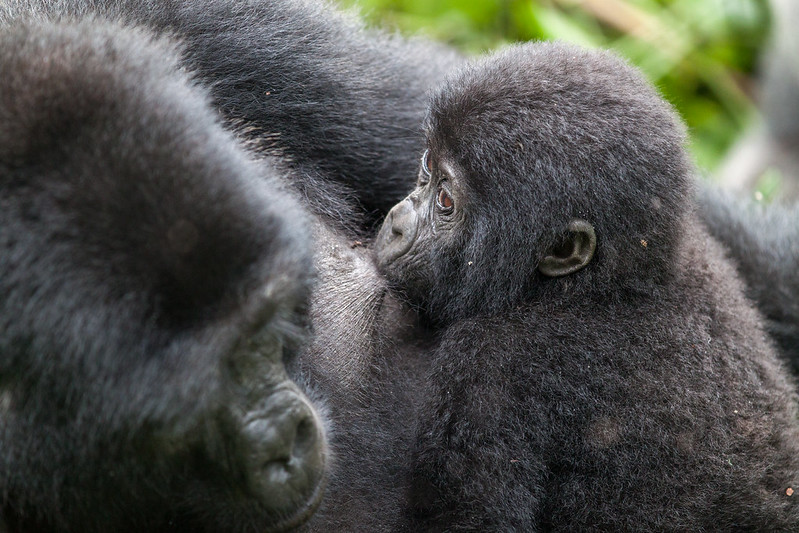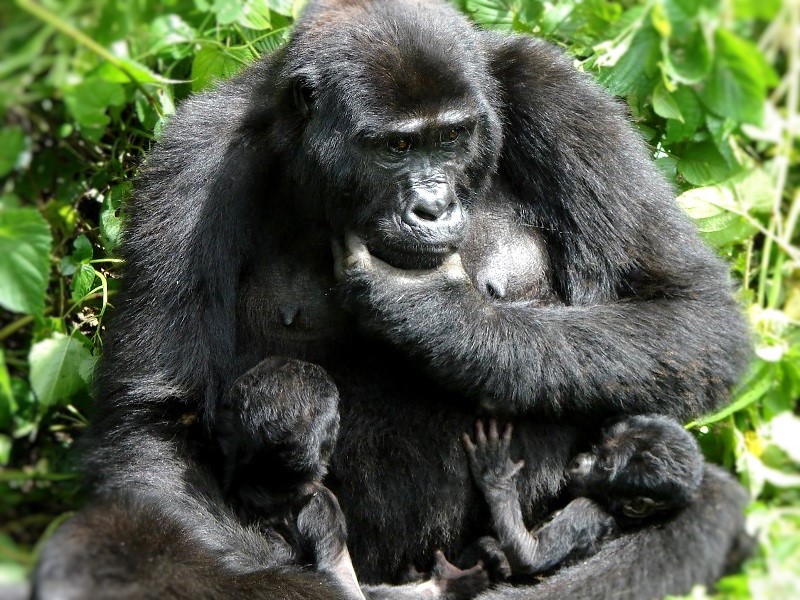Mountain Gorillas are Ugly But Interestingly Attractive to See
Mountain Gorillas are Ugly But Interestingly Attractive to See , Mountain gorillas are substantial, hairy, anthropoid beings characterized by a wide chest and shoulders, recognized as the largest primates on Earth. Gorillas are designated as the second closest relatives of humans, following chimpanzees. This is attributable to the remarkable similarity between these fascinating primates and humans, since they share up to 98% of human DNA, which is shown in their human-like actions and emotions, including laughter, nurturing of offspring, and exhibiting melancholy when ill or experiencing the loss of a companion.
Gorillas possess human-like hands, a prominent brow ridge, and small eyes embedded in hairless faces, with a bony ridge extending from the frontal to the posterior aspect of the head.
Mountain Gorilla Species in Africa
Mountain Gorillas are Ugly But Interestingly Attractive to See, Only two species of gorillas inhabit Africa. Western gorillas, sometimes known as lowland gorillas, inhabit lowland areas and possess a limited population. Lowland gorillas inhabit the Congo region west of the Congo River. Another species is the mountain gorilla, which resides in the Virunga Ranges, spanning three countries: Rwanda, Uganda, and the Democratic Republic of Congo.
Mountain gorillas inhabit groupings termed troops, each overseen by an adult male known as the “Silverback.” The term “silverback” derives from the silver patch of hair on their backs. Their lengthy black hair and dense, shaggy coats provide insulation in frigid environments. The silver hair that has emerged closely resembles the grey hair that humans acquire with aging.

Mountain Gorilla Species in Africa
Indeed, mountain gorillas are undoubtedly the most endangered primates. Only 900 individuals of these gorillas remain globally, confined to the tropical rainforests of East and Central Africa. Gorillas defend themselves from threats by standing upright on their hind legs, uprooting and hurling vegetation, drumming on their chests with their hands or fists, stamping their feet, striking the ground with their palms, and emitting groaning sounds.
What Motivates People to Trek to Mount Gorillas Today?
Several factors contribute to the contemporary allure of gorillas, primarily the natural and anthropogenic risks they face, which have fostered a belief in their potential extinction, significantly enhancing their appeal throughout Africa.
Lowland gorillas are thought to be at risk for a heart disorder termed “fibrosing cardiomyopathy,” characterized by aberrant heart muscle, which is a prevalent cause of heart failure and/or abrupt death in middle-aged or old great apes, particularly in males.
Gorillas globally are perishing due to a sickness, dietary issues, and a certain plant. Seventy percent of male gorillas over the age of 30 succumb to cardiac disease, primarily fibrosing cardiomyopathy. Researchers hypothesize that a bacterial or viral infection of the heart may be the cause of the illness. The poaching, hunting, trade, and consumption of gorillas in the Congo Basin, where the majority of gorillas and other primates reside, persists unabated due to inadequate enforcement of national and international laws, coupled with poor judicial systems.

In Central and West Africa, there is significant demand for bushmeat in commercial commerce, particularly for ape meat, which poses a threat to gorillas today. The consumption of ape meat is seen as prestigious among the affluent elite. Determining the precise number of gorillas poached is challenging due to the fact that they are frequently slaughtered and consumed immediately, or their flesh is smoked and subsequently sold.
The poor reproduction rates of gorillas indicate that even minimal hunting can lead to a population decrease, which may require many generations to recover. Gorillas are often lethally ensnared by traps designed for other forest fauna, such as antelopes.
Gorillas are reportedly utilized in traditional medicine and the live animal trade. They are sought after as pets or trophies and for their body parts, which are utilized in medicine and as magical talismans.
Forests are being rapidly destroyed for road construction, commercial logging, and subsistence agriculture, complicating the survival of gorillas.
Mountain Gorillas are Ugly But Interestingly Attractive to See, Gorillas and other apes are implicated in the transmission of infectious diseases, including Ebola, which led to significant die-offs of great apes during the Ebola hemorrhagic fever outbreak in the early 1990s. The 1994 epidemic in Minkébé, northern Gabon, eradicated the entire population of what was formerly the second-largest protected population of gorillas and chimpanzees globally.
Between 2002 and 2003, the Ebola virus resulted in several fatalities among humans in the northern Republic of Congo, and at two research locations in and around Odzala National Park, 95 percent of the 600 confirmed gorillas perished, presumably due to the same virus. The gorilla trekking tourism sector significantly benefits the people surrounding the national parks. Tourism provides employment and economic advantages that generate favorable outcomes for gorilla conservation. The local population derives significant benefits from gorilla tourism, as gorillas are increasingly seen as lucrative, long-term visitor attractions.
The increase in local investments, both economic and social, fosters the protection of gorillas, ensuring ongoing benefits in education, healthcare, and economic incentives. Currently, gorillas are being conserved, in contrast to the past when they were regarded as food sources, unlucky victims of hunting snares, rivals for habitat, hunting trophies, and targets for unsustainable financial gains from poaching. In many instances, former poachers have transitioned to become game rangers, serving as anti-poaching patrols that are essential for the preservation of gorillas.
A traveler desiring to observe a gorilla must purchase a gorilla trekking permit. A visitor compensates the park authorities for trekking expeditions, thereby aiding gorilla conservation by financing the operation of the parks. He/she resides in local lodges, engages local operators, partakes in local activities, and dines in local establishments, so bolstering the local economy and fostering healthier communities in and around the national parks that serve as safe havens for gorillas in the rainforests.
It is highly recommended that you wear a surgical mask while in the presence of gorillas, adhere to regulations, heed your guide’s advice in the forest, and refrain from trekking if feeling unwell.
